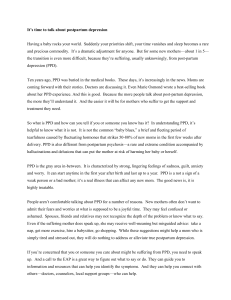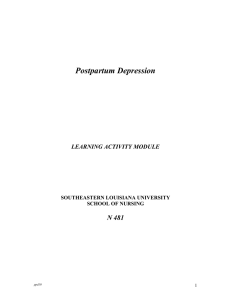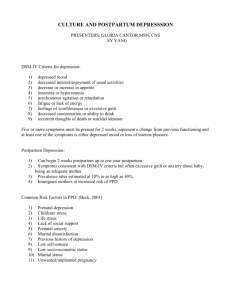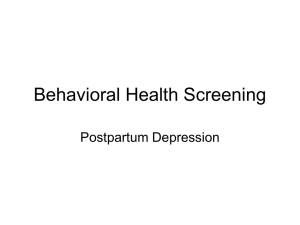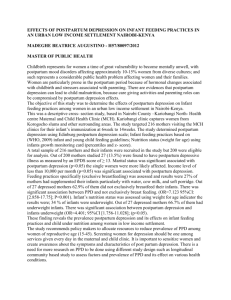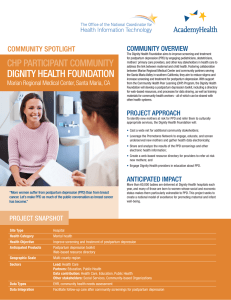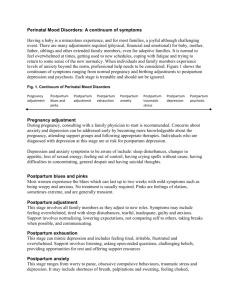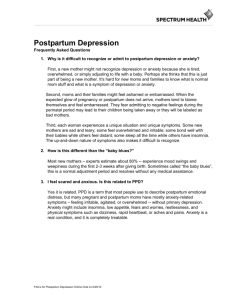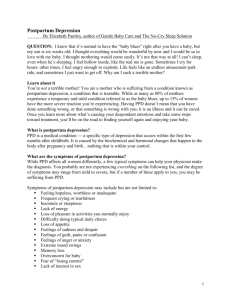PPD Summary 2011
advertisement
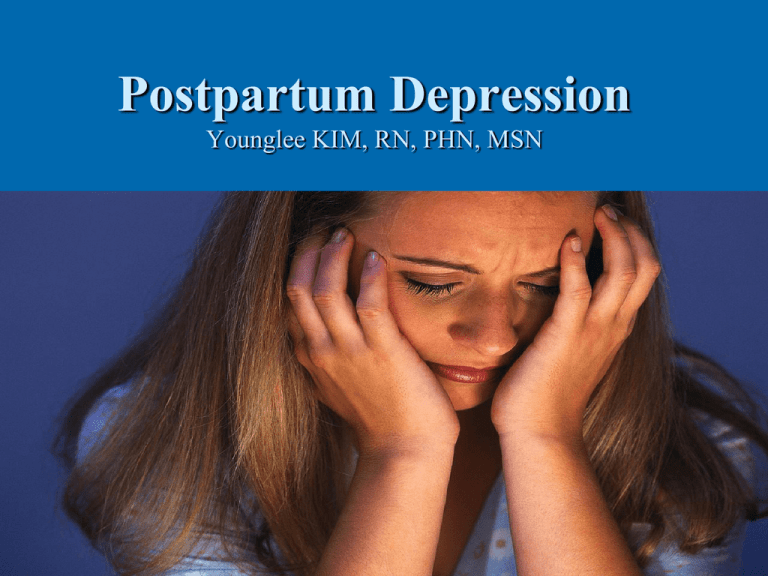
Postpartum Depression Younglee KIM, RN, PHN, MSN Today class objectives To understand importance of PPD care To verbalize correct symptoms of PPD To understand how to use the EPDS screening tool 2 Introduction Over the centuries, normal thought is that the moment when a pregnant woman delivers her child that it will be a special and precious moment for her, but studies show that is not always so. Unfortunately, all of women have not felt joy and feeling of pleasure normally associated with bring a new life into this world. Many of women have reported depressed mood, fatigue, and feeling of worthless or excessive. Family members easily ignore mothers’ feelings of unhappiness and sandiness during postpartum period Medical attention has tended to ignore the seriousness of PPD, too. The broad meaning of depression Depression is probably the most common psychiatric complaint, and it was called melancholia. The course of the disorder is extremely variable from persons to persons. It may be mild or severe, acute or chronic. In psycho logy, it is about feelings of low self – worth or guilt and a reduced ability to enjoy life. Hormonal change decrease the levels of progesterone and estrogen after placental delivery cause a change in the neurotransmitter levels in leading to symptoms of depression (Cohen & Nonacs, 2005) Three terms of depression during the postpartum period; postpartum blues (the baby blues), postpartum depression (PPD), and postpartum psychosis. Postpartum blues (baby blues) Incidence Onset Duration Symptoms 50% -80% Day 2-5 Few days Changed mood Episodic tearfulness Irritability, Anxiety Overwhelming Lost appetite Sleeping problem Postpartum depression (PPD) Incidence Onset Duration 5-15% the first 2 weeks-3 months Up to 1 year Symptoms Depressed mood, Sleep changes Anxiety Fatigue Feeling worthless Inability to concentrate Suicide plan or attempt Postpartum psychosis Incidence Onset Duration Symptoms 0.1% the first 2 weeks-6 weeks Weeks to months Irritability Confusion Psychotic symptoms Delusion Hallucination The symptoms of PPD 1. 2. 3. 4. 5. 6. 7. 8. 9. 10. Depressed mood. Loss of interest or pleasure in activities of life. Sleep changes. Agitation or retardation in movements. Fatigue or loss of energy. Feeling worthless or excessive inappropriate guilt. Inability to concentrate or think; being indecisive every day. Thought of death, suicidal ideation without a plan or a suicide plan or attempt. Somatic symptoms, including headache, constipation, diarrhea and severe anxiety. Shame and low self-esteem. the American Psychiatric Association (APA) The significant predicators of PPD 1. 2. 3. 4. 5. 6. 7. 8. History of prenatal anxiety Occurrence of postpartum blues Low self-esteem A stressful life resulting in excessive demands Lack of social support from family and friends A strained material relationship The nature of the infant’s temperament Childcare stress (Lintner & Gray, 2006) Screening tools Center of Epidemiological Studies-Depression Scale (CES-D) Edinburgh Postnatal Depression Scale (EPDS) Postpartum Depression Screening Scale (PDSS) Beck Depression Inventory Second Edition (BDIII) The CES-D ---The scale consists 20 items, with four responses ranging from “rarely” to “most of the time”, and measure depressive symptoms occurring during the past week The PDSS --- It consists 35 items and assesses for dimensions of depression related to sleeping/ eating disturbances, anxiety/ insecurity, emotional liability, loss of self, guilty/ shame, cognitive impairment, contemplating harming oneself and thoughts of suicide. The BDI-II--- It includes a 21 –items, multiple-choice screening tool that assesses for the presence of depression, as well as the severity of depression, and corresponds well with DSM-IV-TR. The EPDS A commonly recommended screening tool of PPD. The question based on mother’s feelings over the past 7 days 10 items to detect prenatal and postnatal depression. The English and Spanish versions The total score is ranged from 0 to 30. The bigger score means a more severely depressed Possible Depression: 10 or greater Severe condition: 13 or greater Always look at item 10 (suicidal thoughts) The practice Thank you!

